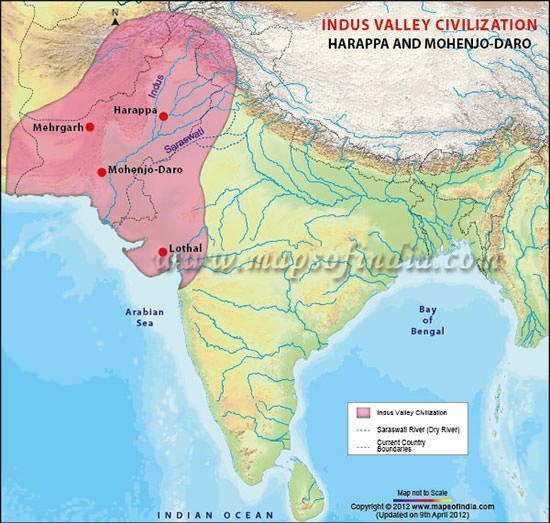10 INTERESTING FACTS ABOUT THE INDUS VALLEY CIVILIZATION
By Anirudh - July 1, 2016
Indus Valley Civilization (IVC), also known as Harappan Civilization after its first find-spot Harappa, was the largest of the four great ancient civilizations. It covered an area consisting of most of modern Pakistan, a significant part of India and parts of Afghanistan. It lasted for at least 1600 years. Its beginning date is not yet known but it did collapse due to unknown reasons somewhere around 16th century BC. Indus Valley Civilization is famous for its advanced engineering, well planned cities and a drainage system which wouldn’t be bettered for many centuries. Here are 10 interesting facts about the advanced features of the Harappan Civilization as well as its famous structures, artifacts, society, and its discovery in modern times.
#1 FIRST RECORDED NOTE OF THE RUINS OF THE CIVILIZATION WAS MADE BY A BRITISH ARMY DESERTER
The first recorded note of the discovery of Indus Valley Civilization (IVC) was made in an 1842 book by James Lewis. Lewis was a British East India Company soldier who deserted the army and while travelling through the Punjab province in British India saw the ruins of the ancient civilization at a small town called Harappa. By 1872, brick robbing had destroyed the upper layer of the site. These hard well-burnt bricks were primarily used to build a railway bed being constructed by the British. Though finds at Harappa were reported, it was not until 1920 that proper excavations began at Harappa under John Marshall, the then director of the Archaeological Survey of India (ASI). These excavations resulted in the discovery of IVC. Due to the common archaeological convention of naming a civilization after its first find-spot, IVC is also known as the Harappan Civilization.
#2 IT IS THE LARGEST OF THE FOUR GREAT ANCIENT CIVILIZATIONS AND PROBABLY THE OLDEST
Excavation of the sites of the Indus Valley Civilization is an on-going process and by 1999, 1,056 cities and settlements had been found. IVC flourished in the basins of two major rivers: Indus River, which remains one of longest in Asia; and Ghaggar-Hakra River, which is identified by many scholars as the dried up form of what was once the Sarasvati River. IVC encompassed most of Pakistan, a significant part of India and parts of Afghanistan. With an area around the size of Western Europe, it is the largest of the four ancient civilizations of Egypt, Mesopotamia, India and China. The era in which IVC existed is not known yet. According to a May 2016 study published in the prestigious Nature journal, experts now believe that the Harappan Civilization is 8,000 years old – 2,500 years older than previously thought. This would make IVC older than the Egyptian and Mesopotamian civilizations.

#3 INDUS VALLEY CITIES WERE ENGINEERING MASTERPIECES OF THE TIME
Harappa, Mohenjo-Daro and other Indus Valley cities had a level of architectural planning that was unparalleled in the ancient world. For protection from seasonal floods and polluted waters, the settlements were built on giant platforms and elevated grounds. The network of streets in the cities formed an orderly grid, being laid out in straight lines cutting each other at right angles. The buildings along the roads were all constructed of bricks that were uniform in size. The houses had connected outer walls which formed a barrier to the noise and dust on the street. Narrow passages through this outer wall led to a common courtyard for several houses which can be considered as a neighborhood compound.
More:
https://learnodo-newtonic.com/indus-valley-civilization-facts
 = new reply since forum marked as read
= new reply since forum marked as read
